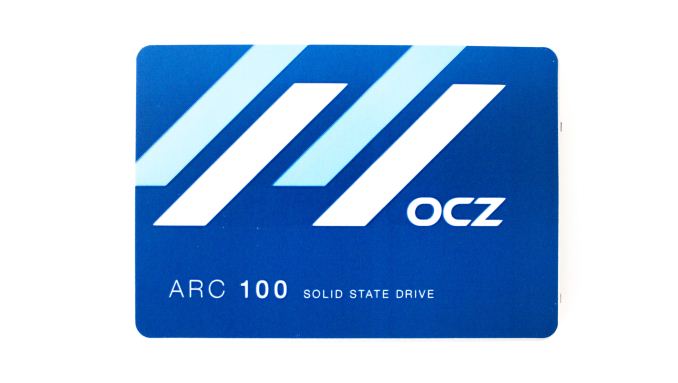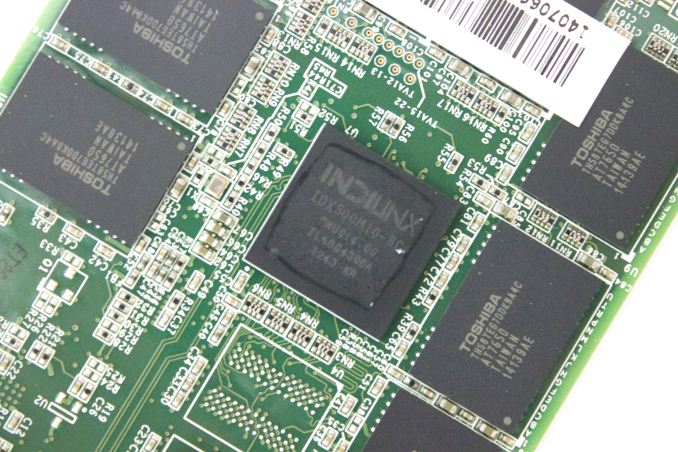OCZ ARC 100 (240GB) SSD Review
by Kristian Vättö on August 26, 2014 7:00 AM EST
Ever since Ryan Petersen, the founder and former CEO of OCZ, resigned almost exactly two years ago, the company has had a new direction. Starting with the launch of the Barefoot 3 platform and the Vector SSDs in late 2012, OCZ has been trying to rebrand itself as a premium manufacturer of high performance SSDs instead of being a budget brand. The old OCZ would have taken the Barefoot 3 controller and stuffed it inside several other models to cater to more price points, but the new OCZ played their cards right. The Vector remained as the only Barefoot 3 based product for months until OCZ introduced the Vertex 450, which was not exactly cheap but a more mainstream version of the Vector with a shorter three-year warranty.
Now, almost two years later after the introduction of the Barefoot 3, OCZ is back in the mainstream SSD game with the ARC 100. The asynchronous NAND from the Agility days is long gone and the ARC 100 uses Toshiba's latest 64Gbit A19nm MLC NAND. In theory the performance will drop a bit but the ARC 100 should hit lower price points. Here's the quick overview:
| OCZ Consumer SSD Lineup | |||||||||
| ARC 100 | Vertex 460 | Vector 150 | |||||||
| Controller | Barefoot 3 M10 | Barefoot 3 M10 | Barefoot 3 M00 | ||||||
| NAND | 64Gbit A19nm | 64Gbit 19nm | 64Gbit 19nm | ||||||
| Sequential Speed | Up to 490MB/s | Up to 545MB/s | Up to 550MB/s | ||||||
| Random Speed | Up to 80K IOPS | Up to 95K IOPS | Up to 100K IOPS | ||||||
| Accessories | - | Cloning Software & Desktop Adapter | |||||||
| Endurance | 20GB per day | 20GB per day | 50GB per day | ||||||
| Warranty | 3 Years | 3 Years | 5 Years | ||||||
The smaller process node NAND and the lack of accessories is the secret behind ARC 100's lower cost. Performance takes a slight hit from the newer NAND compared to the Vertex 460, though that is expected since NAND performance decreases as the lithography shrinks. Fortunately endurance is still rated at the same 20GB per day for three years, which is more than enough for typical client workloads.
| OCZ ARC 100 Specifications | |||||
| Capacity | 120GB | 240GB | 480GB | ||
| Controller | OCZ Barefoot 3 M10 | ||||
| NAND | Toshiba 64Gbit A19nm MLC | ||||
| Sequential Read | 475MB/s | 480MB/s | 490MB/s | ||
| Sequential Write | 395MB/s | 430MB/s | 450MB/s | ||
| 4KB Random Read | 75K IOPS | 75K IOPS | 75K IOPS | ||
| 4KB Random Write | 80K IOPS | 80K IOPS | 80K IOPS | ||
| Steady-State 4KB Random Write | 12K IOPS | 18K IOPS | 20K IOPS | ||
| Idle Power | 0.6W | 0.6W | 0.6W | ||
| Max Power | 3.45W | 3.45W | 3.45W | ||
| Encryption | AES-256 | ||||
| Endurance | 20GB/day for 3 years | ||||
| Warranty | Three years | ||||
| MSRP | $75 | $120 | $240 | ||
Sadly there is still no support for low power states (slumber and DevSleep), so idle power consumption remains high compared to the competition. The same goes for encryption support as the ARC 100 only supports ATA passwords, whereas the industry is moving towards more secure and easily manageable TCG Opal encryption. OCZ's PCIe controller, the JetExpress, will support both, but in the meantime OCZ's SSDs remain limited to the desktop crowd.
The ARC 100 uses the slower bin of the Barefoot 3, which is clocked at 352MHz. The faster version, M00, that is found inside the Vector 150 runs at 397MHz instead, but the two are otherwise the same. Our 240GB sample (256GiB of raw NAND) has sixteen dual-die packages with each die being 8GB (64Gb) in capacity.
Test Systems
For AnandTech Storage Benches, performance consistency, random and sequential performance, performance vs transfer size and load power consumption we use the following system:
| CPU | Intel Core i5-2500K running at 3.3GHz (Turbo & EIST enabled) |
| Motherboard | AsRock Z68 Pro3 |
| Chipset | Intel Z68 |
| Chipset Drivers | Intel 9.1.1.1015 + Intel RST 10.2 |
| Memory | G.Skill RipjawsX DDR3-1600 4 x 8GB (9-9-9-24) |
| Video Card | Palit GeForce GTX 770 JetStream 2GB GDDR5 (1150MHz core clock; 3505MHz GDDR5 effective) |
| Video Drivers | NVIDIA GeForce 332.21 WHQL |
| Desktop Resolution | 1920 x 1080 |
| OS | Windows 7 x64 |
Thanks to G.Skill for the RipjawsX 32GB DDR3 DRAM kit
For slumber power testing we use a different system:
| CPU | Intel Core i7-4770K running at 3.3GHz (Turbo & EIST enabled, C-states disabled) |
| Motherboard | ASUS Z87 Deluxe (BIOS 1707) |
| Chipset | Intel Z87 |
| Chipset Drivers | Intel 9.4.0.1026 + Intel RST 12.9 |
| Memory | Corsair Vengeance DDR3-1866 2x8GB (9-10-9-27 2T) |
| Graphics | Intel HD Graphics 4600 |
| Graphics Drivers | 15.33.8.64.3345 |
| Desktop Resolution | 1920 x 1080 |
| OS | Windows 7 x64 |
- Thanks to Intel for the Core i7-4770K CPU
- Thanks to ASUS for the Z87 Deluxe motherboard
- Thanks to Corsair for the Vengeance 16GB DDR3-1866 DRAM kit, RM750 power supply, Hydro H60 CPU cooler and Carbide 330R case












54 Comments
View All Comments
blackmagnum - Tuesday, August 26, 2014 - link
I'd rather have the cheaper/faster SanDisk Extreme II and its 10-year warranty.Lonyo - Tuesday, August 26, 2014 - link
10 year warranty doesn't mean much. In 5 years, if it dies you would probably just replace it with something far faster and cheaper. The warranty doesn't get you your data back, it just gets you a replacement drive.After 3 years you might like a replacement drive, but much more than that and it becomes pretty meaningless to get a replacement slow/old drive considering how quickly SSDs have advanced. A 10 year warranty is pretty meaningless for this type of product, which is probably why Sandisk are happy to offer it. It gives false peace of mind and they know most people wouldn't take them up on it.
FunBunny2 - Tuesday, August 26, 2014 - link
-- but much more than that and it becomes pretty meaningless to get a replacement slow/old drive considering how quickly SSDs have advancedWe got the Great Recession because Bankster asserted that home prices, which had been exponentially rising, would do so forever. We're near, if not at, the asymptotic limit of node, esp. for NAND. Controller logic & error correction can do only so much.
If the industry can invent a smaller, non-destructive written, piece of memory (which responds to current semi-conductor logic) then may be. But, were I to be betting, I'd bet that consumer SSD will be only marginally better in 3 years.
Kristian Vättö - Tuesday, August 26, 2014 - link
That is what 3D NAND is for.xenol - Tuesday, August 26, 2014 - link
I'd argue raw bandwidth is really that important considering that RAM disks which is comfortably over 10 times faster than an SSD in terms of bandwidth for sequential and smaller reads still don't offer a huge performance improvement over an SSD that an SSD provides over an HDD (and even then, it's not linear). "Loading" at this point is initialization, and that depends entirely on software.I suppose it'd be nice if we had universal memory, but SSDs are not a good candidate for that.
TheWrongChristian - Tuesday, August 26, 2014 - link
I tell you what, I'd take that bet. With SATA being replaced as the primary interface and 3D NAND, I can easily see peak performance doubling in the next 3 years, and significant improvements in steady state performance.FunBunny2 - Tuesday, August 26, 2014 - link
And what, exactly, will the normal SSD consumer (not an uber-gamer) do with that performance? Would s/he even notice? Will 3D NAND lower the price/byte to spinning rust? I wouldn't bet on that, either. My bet: in 3 years consumer SSD will still be performing "good enough" for Joe Sixpack at about the same price as "good enough" does today. What may be different: PC makers, if there are any left, will ship with an SSD rather than a HDD be default, and those with the need for mass storage will buy one with both.oynaz - Wednesday, August 27, 2014 - link
Performance is not the point - space is. You are correct that SSDs are already so fast that even a doubling ot tripling of perfomance will not make much of a difference.However, they are still too small. 256 Gb just doesn't cut it.
... I am not exactly sure where I am going with this ;-)
Kibbles - Saturday, August 30, 2014 - link
Typical usage patterns change with the technology available.Imagine when VR becomes common place. You'd want things to load almost instantaneously because once the computer experience becomes truly interactive, fast response times are so much more important.
leminlyme - Tuesday, September 2, 2014 - link
I LIKE YOU, AND THE WAY YOU THINK. I must add however, that storage and access is not a bottleneck for 3d environments at the moment. If you had such immense immersive environments that our current storage read times were being the bottleneck, I think 780 ti's would be worth 100$ comparitively.